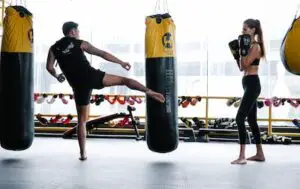As a boxer, having good reflexes is crucial to your success. Reflexes play a major role in your ability to dodge incoming punches and quickly counter-attack. In order to improve your reflexes for boxing, there are a variety of techniques and drills you can incorporate into your training routine.
Why are reflexes important in boxing?
Reflexes are crucial in boxing for several reasons:
- Defensive Maneuvers: Boxing involves both offensive and defensive strategies. Quick reflexes allow boxers to evade punches and avoid getting hit by their opponents. The ability to swiftly move the head, slip, duck, or weave can minimize the impact of incoming punches and reduce the likelihood of sustaining significant damage.
- Counterpunching: Reflexes enable boxers to capitalize on openings created by their opponents’ punches. By instinctively reacting to an opponent’s attack, a boxer with sharp reflexes can swiftly counter with a well-timed punch. This skill can catch the opponent off guard and potentially lead to scoring points or even knocking them out.
- Speed and Accuracy: Reflexes contribute to a boxer’s overall speed and accuracy in delivering punches. The faster a boxer can react to an opening, the more opportunities they have to land punches and score points. Quick reflexes also assist in the precise timing required for effective combinations and defensive maneuvers.
- Slippery Defense: Reflexes play a significant role in a boxer’s defensive techniques, such as slipping punches. Slipping involves moving the head slightly to avoid an incoming punch while staying in position to counter effectively. It requires exceptional reflexes to recognize the direction and speed of the punch in real-time and respond accordingly.
- Adaptability: Boxing matches can be unpredictable, and opponents may employ various strategies and tactics. Good reflexes allow a boxer to adapt quickly to changing situations, such as adjusting their defensive stance, footwork, or punching technique on the fly. This adaptability can give a boxer a competitive advantage during the fight.
How can shadowboxing improve your reflexes?
Shadowboxing is an effective way to improve your reflexes because it allows you to practice your movements and footwork without the distraction of an opponent. When shadowboxing, focus on moving quickly and unpredictably, throwing combinations, and evading imaginary punches.
To make your shadowboxing routine more challenging, you can try incorporating shadowboxing with weights, or practicing shadowboxing with your eyes closed. These exercises will force you to rely more on your reflexes and less on visual cues.
What are reaction ball drills and how can they help?
A reaction ball is a small ball with different curves and angles that bounce in unpredictable directions. Reaction ball drills involve bouncing the ball off a wall and attempting to catch it in your hands. You can also use reaction balls to practice evading punches, by bouncing the ball towards you and attempting to move out of the way.
Reaction ball drills are a fun and effective way to improve your reflexes, as they require quick thinking and reactions. By regularly integrating reaction ball drills into your training routine, you can significantly improve your reflexes and reaction time.
What role does speed bag training play in improving reflexes?
Speed bag training is another effective way to improve your reflexes. The speed bag is a small, lightweight bag that can be striking with quick punches. Speed bag training allows you to practice throwing quick punches while maintaining your balance and footwork.
In addition to working on your punching technique, speed bag training also improves your hand-eye coordination and reaction time. As you become more proficient with the speed bag, try increasing the speed and/or incorporating different punches and combinations.
How can partner drills help improve your reflexes?
Partner drills are a great way to simulate the unpredictability of a real opponent. When practicing partner drills, your partner can throw punches and you can practice evading and counterattacking. These drills can involve sparring and practicing drills that simulate a fight scenario.
Partner drills can be intense and physically demanding, but the benefits in terms of improving your reflexes and overall boxing technique are significant. Be sure to work with a partner who has experience, and always follow safety protocols.
What are some other exercises and drills you can incorporate into your routine?
Finally, there are a variety of other exercises and drills you can incorporate into your training routine to improve your reflexes. These include coordination drills (such as ladder drills), agility drills (such as cone drills), and plyometric exercises (such as box jumps).
Other exercises you can try include practicing catching a medicine ball while standing on one foot, practicing keeping your eyes closed while hitting a speed bag, and practicing against a heavy bag while your coach distracts you with verbal cues.
By incorporating a variety of exercises and drills into your training routine, you can improve your reflexes and overall boxing performance.
Conclusion
In conclusion, reflexes play a critical role in boxing, and there are a variety of exercises and drills you can incorporate into your training routine to improve them. By regularly practicing shadowboxing, reaction ball drills, speed bag training, partner drills, and other exercises, you can significantly improve your reflexes and overall boxing technique. With patience, consistency, and hard work, you can become a more skilled and agile boxer.





